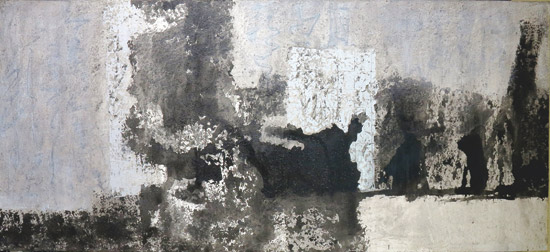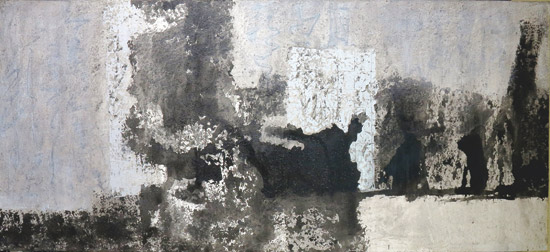(No.1, Vol.4, Jan-Feb 2014 Vietnam Heritage Magazine)
Photos provided by Nguyen Huy Khoi
Eight Gallery’ in Ho Chi Minh City derives its name from its location at number 8 Phung Khoac Khoan Street. With its parquet flooring, tasteful modern furnishing and excellent lighting, not to mention temperature and humidity control systems, it is an excellent hall in which to view paintings. The exhibition I went along to see the other day matches the quality of the venue. I was accompanied by the Editor-in-Chief of this magazine, Mrs Le Thanh Hai, who is already a proud owner of one of the exhibitor’s works. The quiet, unassuming artist himself was there to greet us and talk about his work. His name is Nguyen Huy Khoi. This is his first solo exhibition, although he has participated in many group shows. The collection of some thirty works are all abstract and their qualities, I felt, are aptly summed up by a quote from the preface on display at a central table in the hall by the famous art critic Mr Nguyen Quan ‘persistent, pure and peculiar’ (in the sense of unique).
The first thing I noticed as I entered the gallery was that the artist uses colour very well. Each frame explores shades of a particular colour and this leaves an emotional effect on the viewer. I was struck by the metallic silver, greys and black of a large frame by the entrance. The whole picture reminded me of the beauty of smoke and whilst this is definitely abstract, I discerned the murky shadow of a figure among the fumes. When I asked Mrs Hai which pictures she would most like to own, she first mentioned one with the metallic quality, which, as the artist explained, comes from the use of acrylic. Some works, however, use water colour and indeed, there is a not for sale series of water colours on show that date back twenty years to the artist’s early period. Instead of canvass, most of the paintings are on rice paper.
Secondly, there is in Mr Khoi’s art close juxtaposition of the curve and the straight line. Elements of each picture seem linked together and at times even intertwined. The effect is to have your eyes moving back and forth, up and down the frame. These are two-dimensional compositions, but the effect on the mind is almost that of watching dance. This, at least, was my personal experience; to quote Mr Quan again, ‘do not ask, experience.’
The artist received seven years’ training in Moscow, coming away with a Master’s degree from The V. I. Surikov Moscow State Academy of Art. He is not simply a talented artist, but also a trained one. He passes on this academic training by teaching drawing at University level. The other string to his bow, he told me, is that he is also an illustrator of books.

I asked Mr Khoi what influences from his time in Russia can be seen in his work. He turned to one picture and mentioned he loved the fresco paintings of Russian Orthodox churches. Looking at this painting and the freshness of its colours, I could see his point. The other strong influence is in what can be brought from classical music to this kind of art; after all, both are abstract, both about the emotions. Mr Khoi typically paints diptychs and triptychs. That is to say, in pairs and groupings of three. In his duos, one picture will have one effect on you, while its slightly different partner will give another. In the triptychs, the middle one is larger. It reflects the structure of a classical concerto, which comes in movements of allegro, andante, and rondo. Mr Khoi aims at making you feel joyful looking at the first frame, more sombre and reflective in the second and the last picture, the ‘rondo’ is meant to be fast and furious. Mr Khoi also explained he learned a certain connection between brush stokes and musical notes from the Russians.

Just because something is described as abstract it does not mean to say one can not imagine real figures. Indeed, many who do not understand abstract art might be seeking this out. Both imagination and coincidence play a part here. I liken this to maps which are abstract things formed maybe by nature as in coastlines and islands, but largely by humans drawing lines. One can, however, imagine objects in maps. The map of China together with Korea, for example, looks to me like a big chicken. I stood with the artist watching a slide show on a computer of some of his works not in this exhibition. ‘Oh’, I said, ‘I can see a dog here and a sheep there.’ Mr Khoi seemed quite taken aback. This had clearly not been his intention. Abstract art is there to be experienced and experience will give arise to thoughts which can not be a bad thing.
Mrs Hai too had thought deeply (indeed more than I). Looking at a triptych, she saw an allegory of love. The first one on the left reminded her of the joy of first meeting. The large one in the middle the getting to know someone period and the last one corresponding to the rondo of a concerto-well, we all know how relationships can be fast and furious!
I asked Mr Khoi if he has exhibited outside of Vietnam. Surprisingly, the answer was in the negative. I had also previously asked him what were his interests outside of art and he had said travel. I told him people in my country would love to see his work and perhaps would be a little surprised to see paintings of such quality in a genre of art they normally think of as being only Western. So if there is anyone in the British Council offices, from which it is only a short walk to the exhibition, reading this, please get along to the exhibition to judge for yourself.
Entrance to the exhibition is entirely free, but, of course, the artist would be delighted if you liked his work enough to buy some of it. Prices range from five hundred to three thousand nine hundred dollars per piece. Of course you would have to buy some in pairs or threes. I am not sure, but I do not believe Mr Khoi does ‘buy two get one free’.
I hope this article will inspire some of you to visit the exhibition. It is on until 8 February. It is being held at a very accessible location, which is only around a dollar’s taxi drive from the downtown hotels. I wonder what feelings and musings it will instil in you? If you are unable to attend, I hope I have contributed to arousing some interest in the vibrancy of today’s art scene in Vietnam and in particular in this one artist. Mr Khoi is a modest, quiet unassuming gentleman with a great passion for his work. He may have an exhibition, but he is not an exhibitionist, which is how some artists achieve fame. I am proud and honoured to be able to blow his trumpet!
Nguyen Huy Khoi’s solo exhibition is being held until 8 February, 2014 at Eight Gallery, Lafayette Building, 8 Phung Khoac Khoan Street, District 1, Ho Chi Minh City. Tel: (08) 3824-8490

